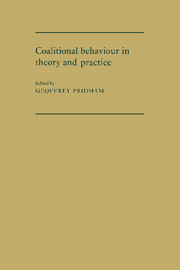Book contents
- Frontmatter
- Contents
- List of illustrations
- List of tables
- Notes on the contributors
- Preface
- 1 An inductive theoretical framework for coalitional behaviour: political parties in multi-dimensional perspective in Western Europe
- 2 Between theoretical elegance and political reality: deductive models and cabinet coalitions in Europe
- 3 Changing coalitional preferences among West German parties
- 4 The FDP and coalitional behaviour in the Federal Republic of Germany: multi-dimensional perspectives on the role of a pivotal party
- 5 Cabinet stability in the French Fourth Republic: the Ramadier coalition government of 1947
- 6 Coalition formation and maintenance in Belgium: a case-study of elite behaviour and changing cleavage structure, 1965–1981
- 7 The Dutch Christian Democratic party and coalitional behaviour in the Netherlands: a pivotal party in the face of depillarisation
- 8 Coalition or Fianna Fail? The politics of inter-party government in Ireland
- 9 Italy's party democracy and coalitional behaviour: a case-study in multi-dimensionality
- 10 Party coalitions in the first democratic period in Spain, 1977–1982
- 11 Coalitional theory and practice in Scandinavia
- 12 Multi-dimensional approaches to the study of local coalitions: some cross-national comparisons
- 13 Research notes
- Index
6 - Coalition formation and maintenance in Belgium: a case-study of elite behaviour and changing cleavage structure, 1965–1981
Published online by Cambridge University Press: 05 November 2011
- Frontmatter
- Contents
- List of illustrations
- List of tables
- Notes on the contributors
- Preface
- 1 An inductive theoretical framework for coalitional behaviour: political parties in multi-dimensional perspective in Western Europe
- 2 Between theoretical elegance and political reality: deductive models and cabinet coalitions in Europe
- 3 Changing coalitional preferences among West German parties
- 4 The FDP and coalitional behaviour in the Federal Republic of Germany: multi-dimensional perspectives on the role of a pivotal party
- 5 Cabinet stability in the French Fourth Republic: the Ramadier coalition government of 1947
- 6 Coalition formation and maintenance in Belgium: a case-study of elite behaviour and changing cleavage structure, 1965–1981
- 7 The Dutch Christian Democratic party and coalitional behaviour in the Netherlands: a pivotal party in the face of depillarisation
- 8 Coalition or Fianna Fail? The politics of inter-party government in Ireland
- 9 Italy's party democracy and coalitional behaviour: a case-study in multi-dimensionality
- 10 Party coalitions in the first democratic period in Spain, 1977–1982
- 11 Coalitional theory and practice in Scandinavia
- 12 Multi-dimensional approaches to the study of local coalitions: some cross-national comparisons
- 13 Research notes
- Index
Summary
Introduction
The formation and maintenance of government coalitions in Belgium have attracted little scholarly research. In English, there have been chapters in the collection of country-specific studies edited by Bogdanor (1983) and by Browne and Dreijmanis (1982). Elsewhere, studies have primarily been historical descriptive accounts (Höjer 1969; Lemaître 1982; Luykx 1978) with a tendency to concentrate upon the constitutional procedures of coalition formation (Delpérée 1983). This dearth of literature is surprising, considering that coalitions have been the predominant form of government in Belgium since the introduction of universal male suffrage in 1919. There were merely nine days of single-party government between the wars and since 1946 there have been only two cases of single-party government – the Christian-Social majority governments of 1950-4 and the Christian-Social minority government of June–November 1958.
Even if traditional coalition theorists were to focus their research upon Belgium, they would be confronted with a number of serious difficulties. Traditional coalition theory, focussing on policy distance and/or ideological similarities between potential coalition partners, rests upon two basic assumptions: (a) that parties are monolithic actors; and (b) that payoffs are discernible prior to coalition negotiations (Axelrod 1970; De Swaan 1973). Both these assumptions, as we shall see later, are violated in the case of Belgium. Belgium presents a further problem in that the country now has three relatively autonomous party subsystems – one in Vlaanderen (Flanders), one in Wallonie and one in Brussels.
- Type
- Chapter
- Information
- Coalitional Behaviour in Theory and PracticeAn Inductive Model for Western Europe, pp. 117 - 144Publisher: Cambridge University PressPrint publication year: 1986
- 3
- Cited by

